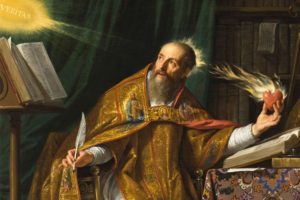If you visit St. Peter’s square before the 15th of April an unexpected and interesting attraction will be waiting for you. In the Braccio di Carlo Magno (i.e. Charlemagne Wing) next to St. Peter’s basilica under Bernini’s colonnade on the right-hand side of the square, an exhibition entitled Verbum Domini (i.e. the Word of the Lord) will call for your attention. The colorful Italian-English brochure that will be put in your hands invites you to “Take a walk through the history of the Bible in this private collection of rare biblical texts and objects of enormous importance.” Admission is free.
Verbum Domini is also the title of the 2010 Post-Synodical Apostolic Exhortation by Benedict XVI in which the Pope summarized the present-day Roman Catholic interpretation of the Word of God, i.e. a living Tradition which includes the Bible and which the Magisterium of the Church interprets faithfully. The connection between the papal text and the exhibition is clear and signals the intent to underline the importance of this topic.
1. A Fascinating Exhibition …
The exhibit was put together from private collections from around the world, mainly from the Green Collection – the largest private collection in the world of rare biblical texts and documents. Displayed in 8 galleries, 152 rare biblical texts and artifacts showcase the history of the Bible: from ancient scrolls to copied texts to printed volumes of the XVII century; from Hebrew to Greek to Latin and other vernacular languages; from Qumran to Europe to the rest of the world.
Here are some of the highlights of the exhibition:
- Codex Climaci Rescriptus—one of the earliest-surviving, near-complete Bibles containing the most extensive early biblical texts in Jesus’ household language of Palestinian Aramaic.
- Scrolls
- The Jeselsohn Stone or Gabriel’s revelation, a three foot tall, 150 pound sandstone tablet discovered near the Dead Sea in Jordan containing 87 lines of first century BCE Hebrew text.
- The Gutenberg Bible Book of Romans, the first book printed in the West with moveable typeset printing.
- Complutensian Polyglot, the first multilingual edition of the entire Bible.
In the first gallery, there are also two half-burnt scrolls of the Torah that escaped total destruction attempted by the Nazis and Stalinists. They are a moving testimony to the on-going battle that surrounds the Bible.
2. The Inter-faith and Ecumenical Intentions
The exhibition has an ambitious goal. In the organizers’ words, “the Verbum Domini, specifically, is a way of celebrating the interfaith love that many traditions have for the Bible, and we believe that is a way of sharing that with the world”. Jewish, Eastern Orthodox, Catholic, and Protestant traditions are all represented in it. From the Vatican side, here is what Cardinal Farina, Prefect of the Vatican Library, said about the exhibition at the inauguration: The title Verbum Domini was chosen to highlight the ecumenical conception of this exhibition, and also its venue here at the Vatican. The origin of the documents, the prevalence of the Green Collection, and those from other collections highlight the participation of the Christian denominations. Because in reality, the Bible unites, even though so many think it does the opposite, it’s actually a very strong point of union.
Fair enough. But why is it that on the brochure that is distributed at the entrance one reads that “this exhibit celebrates the dramatic story of the Catholic contribution to the most-banned, most-debated, best-selling book of all time”? Has the broad contribution to the history of the Bible become a Catholic contribution alone? Perhaps this is a mistake made by a zealous editor, but it may also reflect the provincial culture that each institution (Vatican included) can fall prey to.
3. The Missing Story
The most puzzling point, however, is what the exhibition does not say about the history of the Bible. The unsaid is as telling as what is said. The trajectory of the suggested narrative is “linear” to the point of being historically anemic. The given picture is that the “modern” translations of the Bible in vernacular languages spread out across the Christian spectrum and that each sector of the Christian church championed their diffusion.
The reality is different. Since the XII century the Roman Church has in various instances banned the circulation of Bibles in the peoples’ languages. These bans lead to the compilation of the 1559 Index of Librorum Prohibitorum (Index of Prohibited Books) by Pope Paul IV where Bible translations were among the forbidden books. The attack by the Tridentine Church towards the translations of the Bible allowed historian Gigliola Fragnito to speak of “the Bible on stake” to describe what happened up to the XVII century in countries dominated by the Catholic Church[1], a ban lasted for centuries. A more accurate telling of the story, therefore, is quite different from the mild, peaceful, ecumenical account of the Verbum Domini exhibition.
The Bible is a shared heritage for Christians and this truth is beyond dispute. Therefore historical exhibitions on the Bible should aim at telling the story in a fair and accurate way rather than pursuing ecumenical readings which are unfortunately partial, selective, and therefore in the end misleading. We can all benefit from this example. It is proper and good to celebrate our heritage, but we must do so in a way that tells the complete story, including the unflattering elements.
Leonardo De Chirico
leonardo.dechirico@ifeditalia.org
Rome, 26th March 2012
[1] Gigliola Fragnito, La Bibbia al rogo. La censura ecclesiastica e i volgarizzamenti della Scrittura, 1471-1605 (Bologna: il Mulino, 1997). More recently the same scholar edited the volume Church, Censorship and Culture in Early Modern Italy (Cambridge: Cambridge University Press, 2001).

![middle[1] middle[1]](http://chriscastaldo.com/wp-content/uploads/2012/03/middle1_thumb2.jpg)



